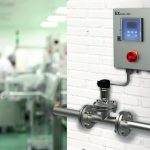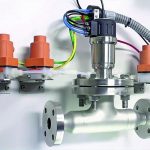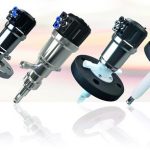A well-designed, automatic rinse control system in combination with the proper retractable sensor housing can improve the availability, lifetime and precision of pH measuring points in hard processes. At the same time, maintenance requirements are reduced. There is no quicker way to cut down processing costs.
When handling liquids in production pro-cesses, plant operators almost inevitably have to perform pH measurements to control the process. Such measurements are performed manually and this can lead to a multitude of problems. The use of retractable sensor housings offers potential for immediate optimi-sation as they allow significant improvements in the availability, lifetime and precision of pH measuring points.
A maintenance-intensive parameter
In the simplest case, measurements are performed in the laboratory via sampling. Most process control systems use online measurements in order to obtain reliable pH values at any time, enabling control and optimisation of the processes. Unfortunately, pH measurement is still a very maintenance-intensive pa-rameter, requiring rather frequent cleaning and adjustment procedures, despite the availability of state-of-the-art analysis technology and digital sensors. Virtually all operators have become used to these time-consuming maintenance tasks, and often they are not aware that there is a much easier and safer option.
As a rule, pH glass sensors will only supply reliable values if they are regularly maintained. That is a fact, even if the most sophisticated amplifier technology is at hand. The better such a sensor is maintained, the longer its lifetime and the more accurate the pH values it will deliver. This becomes very apparent in most laboratory measurements. In a laboratory, the sensor is immersed in the measured medium only briefly before the value is recorded. The sensor is then rinsed and placed in distilled water or KCl solution for storage. This allows sensor lifetimes that can only be dreamt of in hard process applications where the sensor is often subjected to high temperatures under full process pressure while immersed in the medium during the entire process. Clearly, such conditions differ substantially from laboratory environments. Also, manual in-process cleaning of the sensors can only be done every few days since mainte-nance capacity is greatly limited due to the large number of measuring points. This is where most problems emerge in industrial pH measurement. Errors in pH measurements obtained with glass sensors are usually caused by sensor contamination. In many processes, coverings form on the sensors which, after a few days, can only be removed by using highly concentrated cleaning agents, often strong acids. These chemical cleaning agents must act for longer periods of time to become fully effective. Consequently, manual maintenance on a pH measuring point is relatively time-consuming. It is also rather dangerous for operators, because they have to handle aggressive cleaning agents. Hence, maintenance personnel usually do not consider this one of their favourite tasks. As a result, planned mainte-nance work is skipped or not performed adequately, which leads to unreliable measurement values. This creates a vicious circle. In practice, many plant operators have surrendered and are ignoring the problem, not knowing that there is a simple and cost-effective solution.
The solution
The vicious circle described above can easily be broken by using automated retractable sensor housings with a cleaning control system. The retractable sensor housing is at the heart of such a measurement system. If selected and configured properly for the respective process conditions, it will work maintenance-free for many years. Once you have eliminated the maintenance work on a manual measurement point, you don’t want to go right back and do maintenance on the sensor housing. The Extract range of sensor housings can be used for virtually any kind of application. Featuring a very robust PTFE process seal, extremely short stroke movements even when deeply submersed and maintenance-free drives, these sensor housings form the basis for reliable measuring points. The patent-protected rinsing chamber of the Extract product series provides for excellent cleaning of the glass sensor, ensuring the best possible care of the delicate sensors. The Exmatic 460 is precisely tailored to the fittings, making it the perfect rinse control system. The control system is connected to the fitting via a multi-hose. Installation is quick and easy thanks to size and colour-coded hose connections. The program sequence is pre-installed in the controls and only has to be adjusted and parameterised to the various application conditions. The operator is guided through the program step-by-step.
Longer sensor lifetime
Yet how can such a retractable sensor housing and rinse control system improve measurement value availability and sensor lifetime while simultaneously reducing manual servicing requirements? The automated, periodic and consistent rinsing of the sensor and the level of care achieved by it are key to this effect. The rinse control system is specifically designed for the cleaning procedure and adapted to the different process requirements. Thanks to the regular rinsing of the sensor with water and cleaning agents, it is almost impossible for coverings or dirt to accumulate on the sensor. In many applications, rinsing is performed every two hours. The minor deposits that form during the measurement interval are simply rinsed off. Long reaction times, as seen with chemical cleaning agents, become obsolete in most cases because the sensor is returned to the medium for the next measuring task in a clean state, similar to a laboratory measurement.
Due to the fully automated nature of the system, cleaning is performed with such regularity as cannot be achieved by maintenance personnel. When a pH sensor is cared for in this way, its calibration intervals become significantly longer compared to manual measuring points. The same is true with regard to the lifetime of the sensors. Due to greatly reduced manual maintenance activities and the longer sensor lifetime, it is possible to recoup the investment within a few months in most applications. In order to remind operators of the existing pH measuring points, the control system transmits their respective operating condition, measurement or service, and any possible errors directly to a higher process control system. This way, operators always have a complete overview of their measuring points. Of course, the measured value is “frozen” during cleaning to prevent any influence on the current process control. Overall, this solution is a robust, easy-to-use and virtually maintenance-free system that can be used for very long periods of time.
www.cpp-net.com search: cpp0117exner
Detlef Exner
General Manager, Exner Process Equipment
Share:









